Garden’s Main Scenic Spots

Special Scenic Spots of Okayama Korakuen Garden
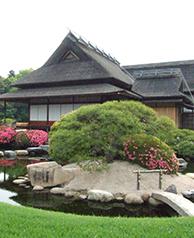
1.En’yō-tei House
This building is considered the most important one in Okayama Korakuen Garden and was used as a place to receive the daimyō (feudal lord) every time he left his manor in the castle citadel to visit the garden. It was built and carefully oriented to allow its occupants to enjoy a wide and beautiful view encompassing elements from inside and outside the garden.
Although the building has been razed to the ground during the Second World War, in 1960 the best materials and technologies available were used to restore the house to the layout it had when the garden was constructed, according to historical documents. There are ongoing efforts to preserve the building and its landscape as beautiful as the daimyōs of the past saw them.
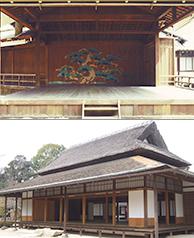
2.Nō Theater Stage and Eishō-no-ma Hall
The founder of the garden Lord Ikeda Tsunamasa was a great admirer and performer himself of Nō, a form of traditional Japanese theater, and requested the construction of this stage. He used to invite his vassals and sometimes even people of the domain to watch the performances. The rooms surrounding the stage on three sides were used both to treat the lord’s guests and to accommodate the audience attending the plays. The stage and the surrounding buildings were refurbished by Lord Tsugumasa, son of Tsunamasa, and maintained this new configuration for centuries.
After being burned to the ground during the Second World War, both the stage and the surrounding hall was faithfully restored based on historical documents.
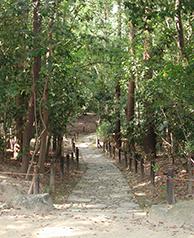
3.Nishiki-ga-oka Grove
The Japanese name Nishiki-ga-oka means “two-colored hill” and it refers to the original vegetation of this grove. When the garden was constructed, the area featured many yamazakura (mountain cherry trees, Prunus jamasakura), blossoming in delicate pink in spring, dotted by various maple trees turning red in autumn and pine trees evergreen, so that the color of the thicket was constantly changing throughout the year. After the Second World War, much of the forest was occupied by evergreen Japanese cedars (Cryptomeria japonica), but restoration work of the original tree arrangement was completed in 2025.
The grove is house to many wild birds, visiting this place as an oasis sitting in a metropolitan area, and to the buildings Moshō-an Rest House and the Buddhist temples Shiten’nō-dō and Jizō-dō.
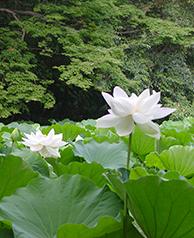
4.Kayō-no-ike Pond
The white flowers of Ittenshikai, a variety of Indian lotus, emerge from the water of the pond and can be seen in their full glory in mid-summer. The water for the pond comes from a waterfall gushing on a beautiful arrangement of rocks: it seems perfectly natural, but it is indeed an artificial spring and its water comes through an underground pipe from the stream flowing in the garden.
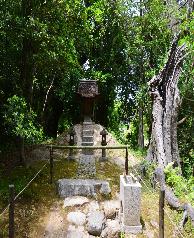
5.Jizō-dō Temple (Six tutelary deities of the garden)
Religious syncretism of Shintō and Buddhism is common in Japan, as can be seen in the six chinjus of Okayama Korakuen Garden. These now deconsecrated little buildings were the dwellings of some “tutelary deities” coming from both religions and worshipped by the feudal lords as protectors of their fiefdom.
Two of these chinjus are bathed in the silence of Nishiki-ga-oka Grove: the small Jizō-dō Temple and the close Shiten’nō-dō Temple. The other four buildings are Yuga Shrine and Nishi-no-Inari-gū Shrine on the north bank of Sawa-no-ike Pond, and Benzaiten-dō Temple and Higashi-no-Inari-gū Shrine next to Chishio-no-mori Grove.
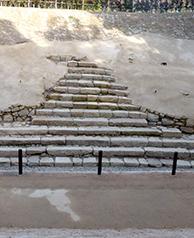
6.Ofunairi-ato Dock Remains
This area once provided a majestic water entrance to the garden for the feudal lords, who lived in the castle citadel and used to get to Okayama Korakuen Garden by boat crossing the Asahi River. The area featured an inlet with a gangi (a landing dock with a stone staircase) leading to the now-lost Onari-go-mon Gate. The river deposited debris and ground in the inlet for centuries until it filled it quite entirely making it unusable. During the Taishō period (1912-1926) the inlet was closed for good to construct a promenade running all around the garden.
Even if no water currently runs in here anymore, the stone gangi has been unearthed and it is now visible.
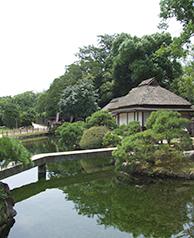
7.Renchi-ken Rest House
Renchi-ken Rest House is one of the buildings that escaped damage during the Second World War and still treasures original parts as they were when the garden was constructed, including the stone bridge stretching across the pond, the small island with a dry garden, and the circular window of the 6-tatami mats tea room.
The feudal lords loved to sit in this building to admire a landscape full of undulations, such as the skyline of the Pine Grove that overlooks Sawa-no-ike Pond and the compelling arrangement of the ponds and the stream, which here flows at different levels.
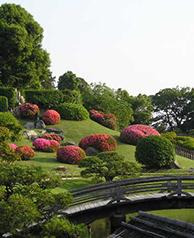
8.Yuishinzan Hill
Yuishinzan Hill was built by Lord Ikeda Tsugumasa, who took over from his father Tsunamasa. It dramatically changed the flat landscape of the garden, giving it a more complex, sculptural aspect.
A small pavilion called Yuishin-dō is located on a side of the hill and it is surrounded by many bushes of azalea, which blossom in late spring in beautiful red and white flowers in striking contrast with the green grass and the rock work on the slopes.
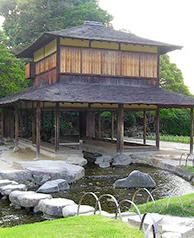
9.Ryūten Rest House
This is one of the buildings that escaped damage during the Second World War and it was used as a resting place for the feudal lords during their strolls through the garden. Although the appearance is quite simple, the architectural structure and the proportion of its elements are indeed exquisitely refined. The stream passing indoor through the floor, with its six stones different in material, size, color and shape, makes this pavilion unique in Japan.
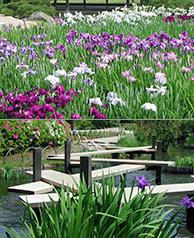
10.Japanese Iris Garden and Yatsuhashi Bridge
Beautiful white, violet and purple iris flowers bloom here in early June giving a special atmosphere to the rainy season. Japanese irises kakitsubata (Iris laevigata) grow in the water next to Yatsuhashi Bridge, which spans the meandering stream, creating a marvelous scene reminiscent of the chapter Going East from the book The Tales of Ise, an ancient collection of Japanese poems.
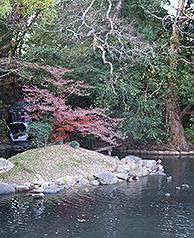
11.Kakō-no-ike Pond
The name of this area comes from a now-lost building called Kakō from which to enjoy the view of the mountain cherry trees (Prunus jamasakura) and other blossoming plants which originally adorned the view around the pond. Poems composed during the Edo period (1603-1868) have been passed down through time portraying how the waterfall makes the flowers seem even more beautiful.
Nowadays the pond is surrounded by a grove of mixed trees.
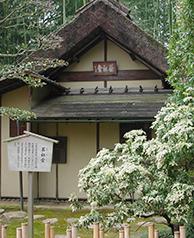
12.Chaso-dō Tea House
This building was originally part of a villa in Okayama belonging to a high-ranking vassal until 1888 when it was relocated to the garden. It was destroyed during the Second World War but faithfully rebuilt in 1961, and on that occasion renamed from Rikyū-dō (“House of Rikyū”) in honor of Sen no Rikyū, the ultimate esthete of the tea ceremony, to Chaso-dō (“House of the Forefathers of Tea”) to both Rikyū and Yōsai (or Eisai), the Okayama-born Zen Buddhist priest said to have brought tea farming and drinking practice from China to Japan.
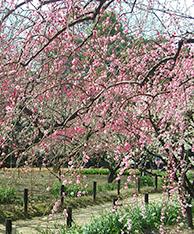
13.Plum Grove
This orchard was established in its present form towards the end of the Edo period (1603-1868), and since then features about 100 Japanese plum trees (Prunus mume) in many varieties blossoming in white, pink and red, with single-flowering and double-flowering buds, growing in straight and weeping branches and so on. Since ume blossoms way before the other trees, it is said it announces the upcoming spring and hence sung in many poems.
Cherry Blossom Grove and Chishio-no-mori Grove are located next to the Ume Grove.
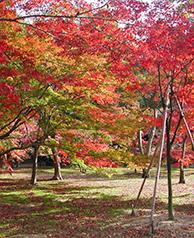
14.Chishio-no-mori Grove
The Japanese maple trees (Acer palmatum) are beautiful in spring when they are in bud, as well as in autumn when their vivid tapestry of auburn hues resembles a Japanese brocade. This grove is one of the most famous scenic spots in Okayama Korakuen Garden and grows on the same location since the foundation of the garden, when it got its metaphorical name Chishio-no-mori (“Dyeing Grove”) in reference to the term chishio, which means “to dye a cloth multiple times”, just like the leaves dye themselves changing colors.
Benzaiten-dō Temple and Higashi-no-Inari-gū Shrine sit next to the grove.
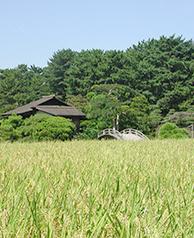
15.Seiden Fields
This area gives the visitors an idea of how Okayama Korakuen Garden originally looked like when rice paddies and vegetable fields covered most of the garden. However, the current fields are shaped differently from the original ones, since those were irregular while these new ones have been made in the 19th century and modeled after the regular Zhōu Dynasty system for taxing rice.
The nine portions are composed of six rice paddies, two Ōga lotus fields and one Chinese peony field. The Rice Planting Festival is held on the second Sunday of June every year.
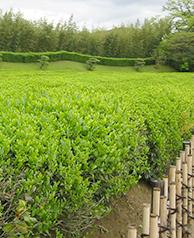
16.Tea Plantation
The Tea Plantation occupies the same area since the garden was built, in harmony with the gentle curves described by the earthen banks on its back. The very high-quality tea produced here was regularly drunk by the feudal lords, and it is still possible to taste it nowadays during the Tea Picking Festival, which is held here every year on the third Sunday of May.
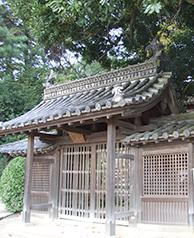
17.Jigen-dō Temple
This temple was constructed in 1697 by Lord Ikeda Tsunamasa and consecrated to Kan’non, the Buddhist goddess of mercy, in order to bring stability to the Ikeda clan and peace to the townspeople. The building is currently empty, but it originally housed two gilded statues of Kan’non and was guarded by two statues of Niō deities; these latter are now on exhibition at the Okayama Prefectural Museum.
Within the precincts there are the Eboshi-iwa (a rock resembling the shape of a crow’s head) composed of 36 blocks of granite, a sanmon (traditional three-bay gate), and a triangular seat at the foot of the temple.
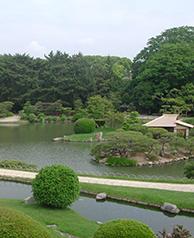
18.Sawa-no-ike Pond
Sawa-no-ike is the largest pond of Okayama Korakuen Garden and sits at the center of the garden. Standing on its north bank, from left to right you can see Shima-jaya Rest House on Naka-no-shima Island, Mi-no-shima Island with Tsuridono Rest House, and Jari-jima Island covered by beautiful white sand, grey rocks and green pines.
The space between Naka-no-shima Island and Mi-no-shima Island once marked the county boundary between the Jōdō-gun and Mino-gun areas of Okayama Prefecture, and two stone markers are still there in memory of their original purpose. The solitary Jari-jima was originally a peninsula.
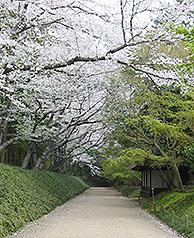
19.Horseback Riding Ground and Archery Range
Okayama Korakuen Garden was built not only as a place for daimyōs (feudal lords) to admire the scenery and enjoying literary arts but also as a training ground for practicing military and martial arts.
Kanki-tei Rest House and Kansha-tei Rest House were two buildings used by the lords to observe displays of horsemanship and archery by their vassals.
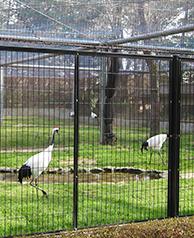
20.Crane Aviary
The garden has been home to many kinds of crane since the 17th century, but all the birds disappeared after the air raid of the Second World War.
In 1956 Guō Mòruò, chairman of the Chinese Academy of Sciences and former exchange student in Okayama at Dairoku High School, donated two red-crowned cranes (Grus japonensis) to the garden. Thanks to the collaboration with the bird experts of Kushiro City, Hokkaidō, it has been possible to successfully breed many cranes, bringing back their once lost beauty to the garden.
Currently, eight cranes are kept in the garden.